CCC3085 Project: Analysis of Bilingual Education in Australian Schools
VerifiedAdded on 2020/03/16
|31
|7420
|329
Report
AI Summary
This report, an integrated business management project, investigates bilingual education within the Australian context. It begins with an introduction and outlines the aim and scope of the study, focusing on the purpose and effectiveness of bilingual education. The literature review explores infant bilingualism, the role of bilingualism in Australia, bilingual education at home and at school, its benefits, and the challenges faced, such as a lack of bilingual teacher training and managerial support. The report also provides recommendations for improvement. The final report includes an executive summary, objectives, research questions, scope and limitations, background information, and proposed operative suggestions, including programs to improve bilingual education in early childhood and strategies to improve bilingual language education. The report emphasizes the importance of bilingual education in a multicultural society like Australia, offering insights for schools, colleges, and universities.
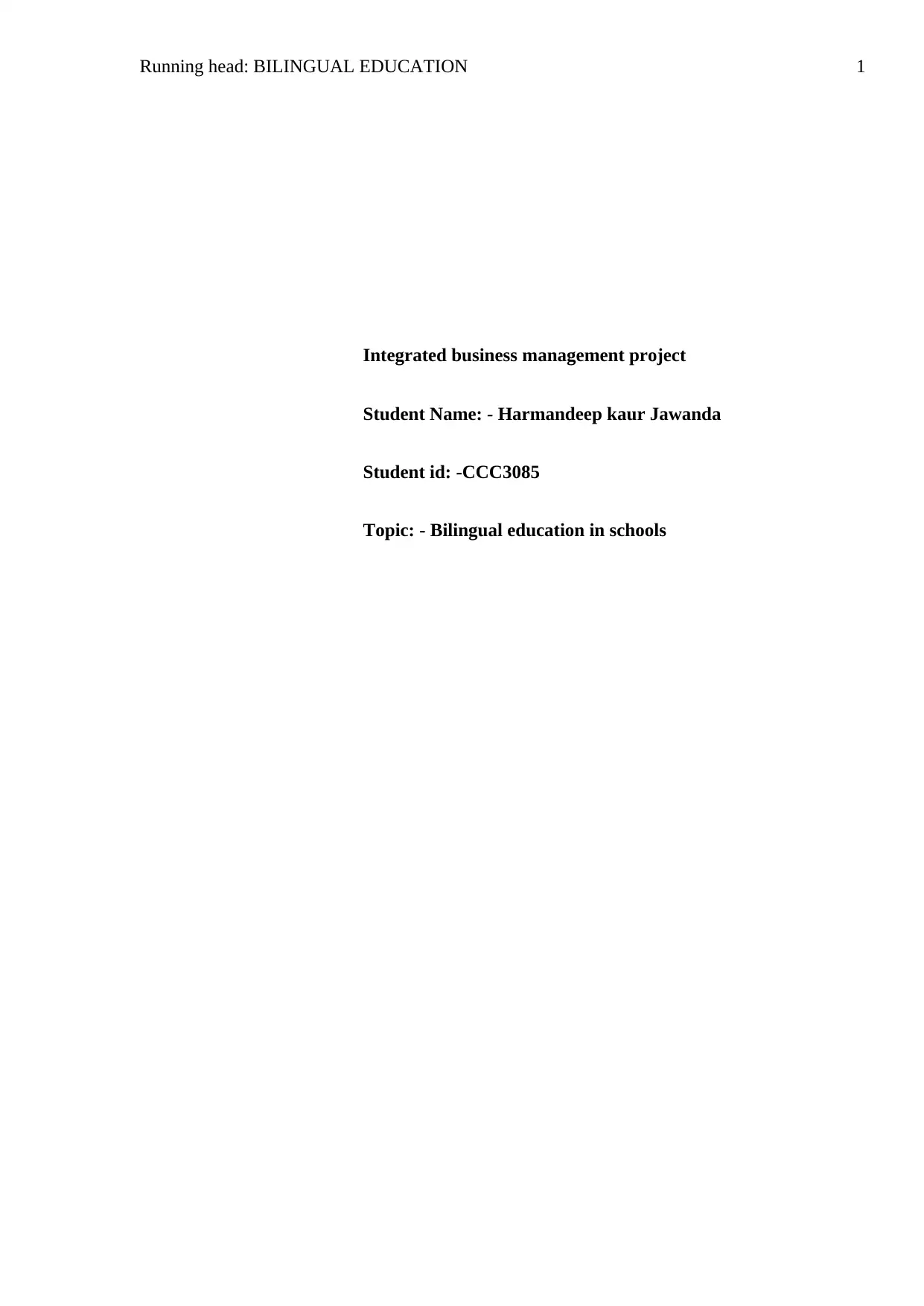
Running head: BILINGUAL EDUCATION 1
Integrated business management project
Student Name: - Harmandeep kaur Jawanda
Student id: -CCC3085
Topic: - Bilingual education in schools
Integrated business management project
Student Name: - Harmandeep kaur Jawanda
Student id: -CCC3085
Topic: - Bilingual education in schools
Paraphrase This Document
Need a fresh take? Get an instant paraphrase of this document with our AI Paraphraser
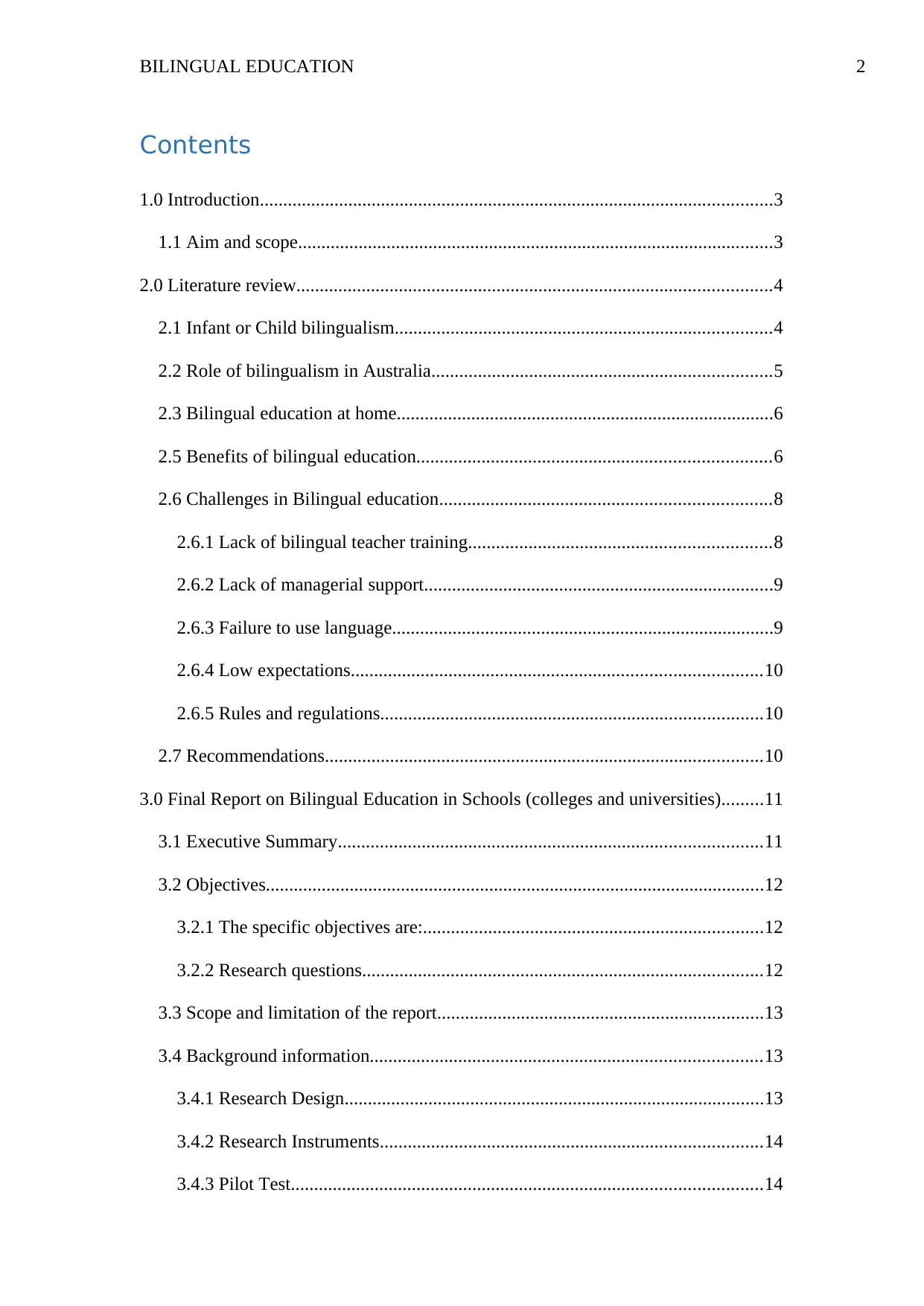
BILINGUAL EDUCATION 2
Contents
1.0 Introduction..............................................................................................................3
1.1 Aim and scope......................................................................................................3
2.0 Literature review......................................................................................................4
2.1 Infant or Child bilingualism.................................................................................4
2.2 Role of bilingualism in Australia.........................................................................5
2.3 Bilingual education at home.................................................................................6
2.5 Benefits of bilingual education............................................................................6
2.6 Challenges in Bilingual education.......................................................................8
2.6.1 Lack of bilingual teacher training.................................................................8
2.6.2 Lack of managerial support...........................................................................9
2.6.3 Failure to use language..................................................................................9
2.6.4 Low expectations........................................................................................10
2.6.5 Rules and regulations..................................................................................10
2.7 Recommendations..............................................................................................10
3.0 Final Report on Bilingual Education in Schools (colleges and universities).........11
3.1 Executive Summary...........................................................................................11
3.2 Objectives...........................................................................................................12
3.2.1 The specific objectives are:.........................................................................12
3.2.2 Research questions......................................................................................12
3.3 Scope and limitation of the report......................................................................13
3.4 Background information....................................................................................13
3.4.1 Research Design..........................................................................................13
3.4.2 Research Instruments..................................................................................14
3.4.3 Pilot Test.....................................................................................................14
Contents
1.0 Introduction..............................................................................................................3
1.1 Aim and scope......................................................................................................3
2.0 Literature review......................................................................................................4
2.1 Infant or Child bilingualism.................................................................................4
2.2 Role of bilingualism in Australia.........................................................................5
2.3 Bilingual education at home.................................................................................6
2.5 Benefits of bilingual education............................................................................6
2.6 Challenges in Bilingual education.......................................................................8
2.6.1 Lack of bilingual teacher training.................................................................8
2.6.2 Lack of managerial support...........................................................................9
2.6.3 Failure to use language..................................................................................9
2.6.4 Low expectations........................................................................................10
2.6.5 Rules and regulations..................................................................................10
2.7 Recommendations..............................................................................................10
3.0 Final Report on Bilingual Education in Schools (colleges and universities).........11
3.1 Executive Summary...........................................................................................11
3.2 Objectives...........................................................................................................12
3.2.1 The specific objectives are:.........................................................................12
3.2.2 Research questions......................................................................................12
3.3 Scope and limitation of the report......................................................................13
3.4 Background information....................................................................................13
3.4.1 Research Design..........................................................................................13
3.4.2 Research Instruments..................................................................................14
3.4.3 Pilot Test.....................................................................................................14
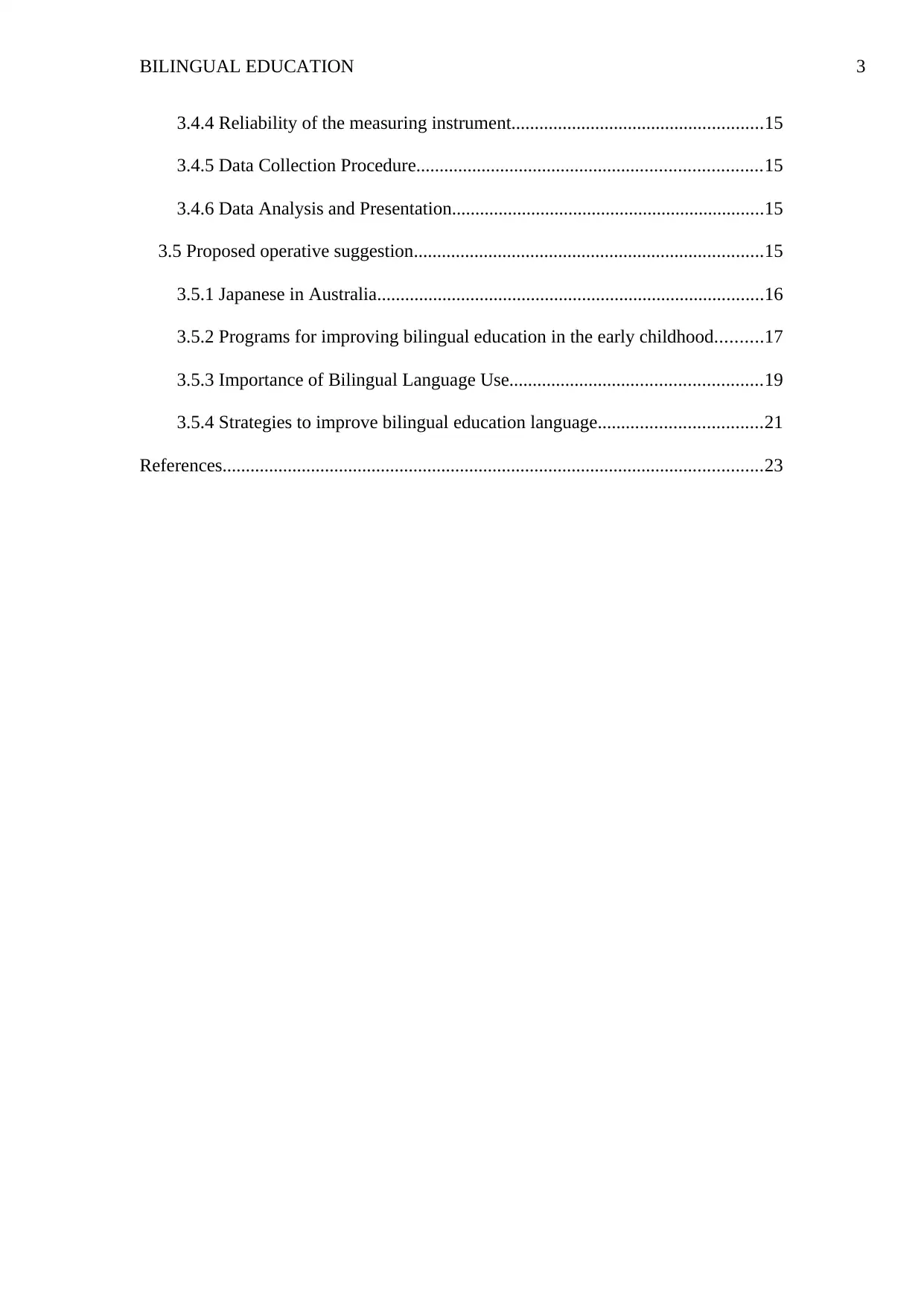
BILINGUAL EDUCATION 3
3.4.4 Reliability of the measuring instrument......................................................15
3.4.5 Data Collection Procedure..........................................................................15
3.4.6 Data Analysis and Presentation...................................................................15
3.5 Proposed operative suggestion...........................................................................15
3.5.1 Japanese in Australia...................................................................................16
3.5.2 Programs for improving bilingual education in the early childhood..........17
3.5.3 Importance of Bilingual Language Use......................................................19
3.5.4 Strategies to improve bilingual education language...................................21
References....................................................................................................................23
3.4.4 Reliability of the measuring instrument......................................................15
3.4.5 Data Collection Procedure..........................................................................15
3.4.6 Data Analysis and Presentation...................................................................15
3.5 Proposed operative suggestion...........................................................................15
3.5.1 Japanese in Australia...................................................................................16
3.5.2 Programs for improving bilingual education in the early childhood..........17
3.5.3 Importance of Bilingual Language Use......................................................19
3.5.4 Strategies to improve bilingual education language...................................21
References....................................................................................................................23
⊘ This is a preview!⊘
Do you want full access?
Subscribe today to unlock all pages.

Trusted by 1+ million students worldwide
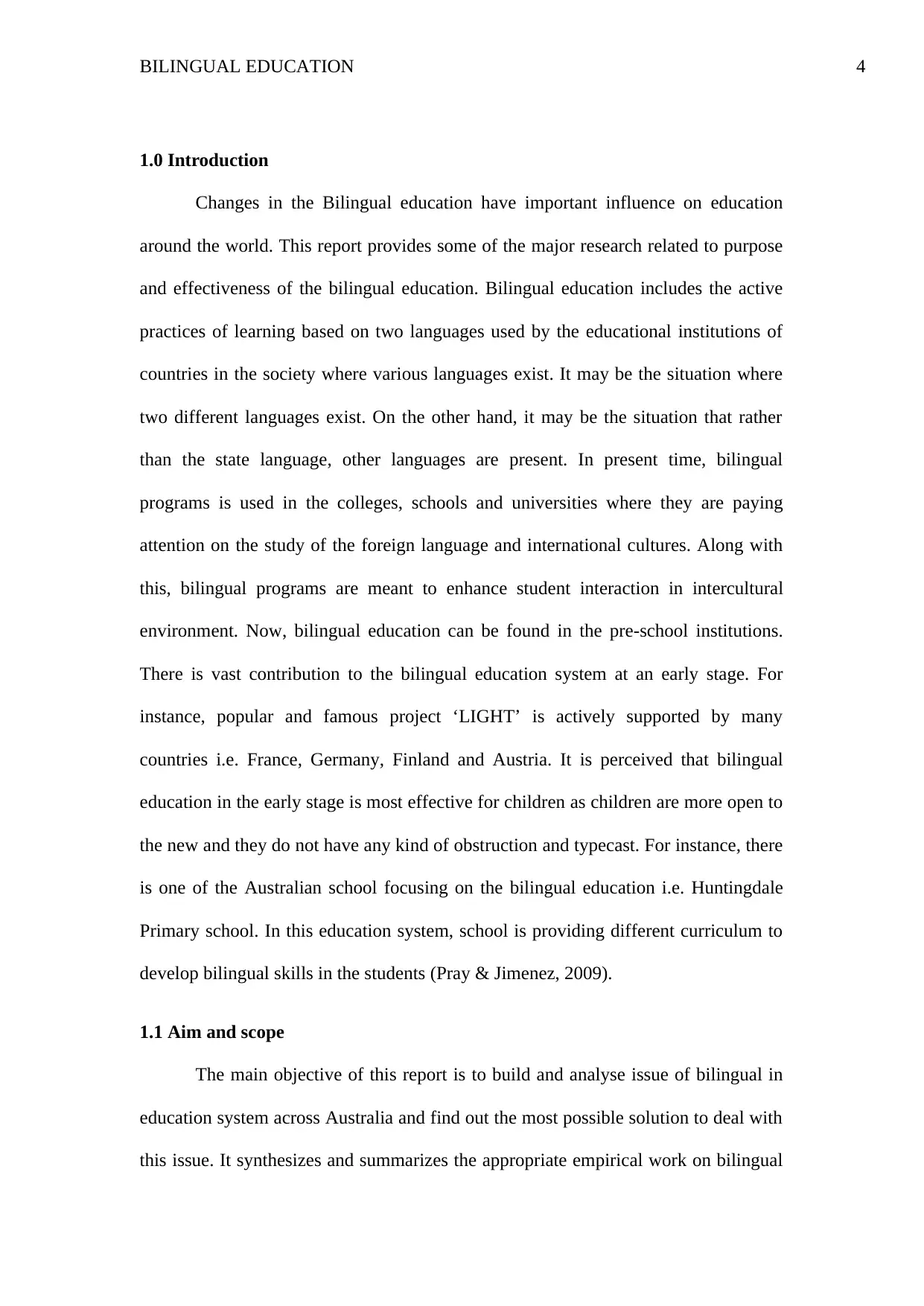
BILINGUAL EDUCATION 4
1.0 Introduction
Changes in the Bilingual education have important influence on education
around the world. This report provides some of the major research related to purpose
and effectiveness of the bilingual education. Bilingual education includes the active
practices of learning based on two languages used by the educational institutions of
countries in the society where various languages exist. It may be the situation where
two different languages exist. On the other hand, it may be the situation that rather
than the state language, other languages are present. In present time, bilingual
programs is used in the colleges, schools and universities where they are paying
attention on the study of the foreign language and international cultures. Along with
this, bilingual programs are meant to enhance student interaction in intercultural
environment. Now, bilingual education can be found in the pre-school institutions.
There is vast contribution to the bilingual education system at an early stage. For
instance, popular and famous project ‘LIGHT’ is actively supported by many
countries i.e. France, Germany, Finland and Austria. It is perceived that bilingual
education in the early stage is most effective for children as children are more open to
the new and they do not have any kind of obstruction and typecast. For instance, there
is one of the Australian school focusing on the bilingual education i.e. Huntingdale
Primary school. In this education system, school is providing different curriculum to
develop bilingual skills in the students (Pray & Jimenez, 2009).
1.1 Aim and scope
The main objective of this report is to build and analyse issue of bilingual in
education system across Australia and find out the most possible solution to deal with
this issue. It synthesizes and summarizes the appropriate empirical work on bilingual
1.0 Introduction
Changes in the Bilingual education have important influence on education
around the world. This report provides some of the major research related to purpose
and effectiveness of the bilingual education. Bilingual education includes the active
practices of learning based on two languages used by the educational institutions of
countries in the society where various languages exist. It may be the situation where
two different languages exist. On the other hand, it may be the situation that rather
than the state language, other languages are present. In present time, bilingual
programs is used in the colleges, schools and universities where they are paying
attention on the study of the foreign language and international cultures. Along with
this, bilingual programs are meant to enhance student interaction in intercultural
environment. Now, bilingual education can be found in the pre-school institutions.
There is vast contribution to the bilingual education system at an early stage. For
instance, popular and famous project ‘LIGHT’ is actively supported by many
countries i.e. France, Germany, Finland and Austria. It is perceived that bilingual
education in the early stage is most effective for children as children are more open to
the new and they do not have any kind of obstruction and typecast. For instance, there
is one of the Australian school focusing on the bilingual education i.e. Huntingdale
Primary school. In this education system, school is providing different curriculum to
develop bilingual skills in the students (Pray & Jimenez, 2009).
1.1 Aim and scope
The main objective of this report is to build and analyse issue of bilingual in
education system across Australia and find out the most possible solution to deal with
this issue. It synthesizes and summarizes the appropriate empirical work on bilingual
Paraphrase This Document
Need a fresh take? Get an instant paraphrase of this document with our AI Paraphraser
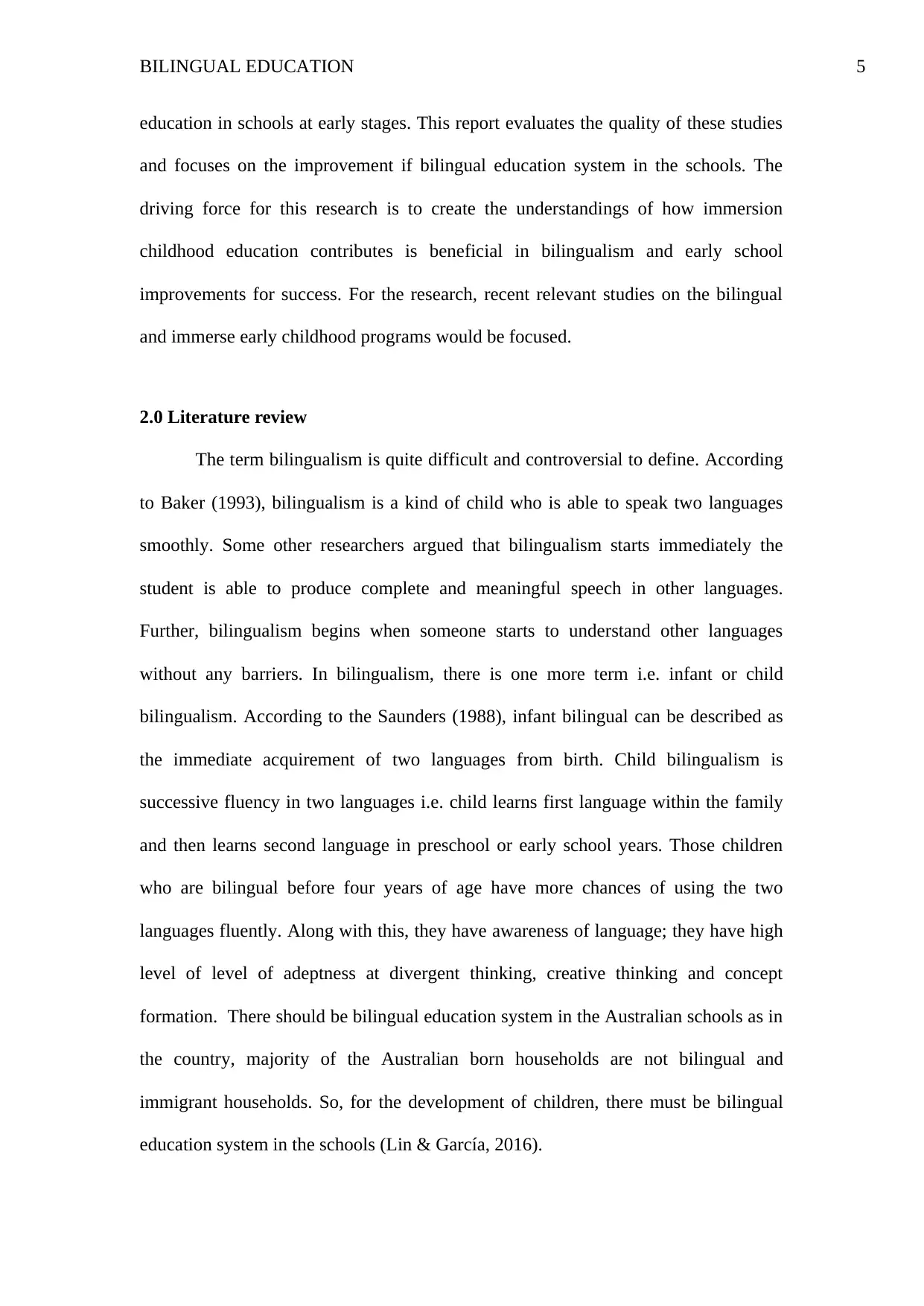
BILINGUAL EDUCATION 5
education in schools at early stages. This report evaluates the quality of these studies
and focuses on the improvement if bilingual education system in the schools. The
driving force for this research is to create the understandings of how immersion
childhood education contributes is beneficial in bilingualism and early school
improvements for success. For the research, recent relevant studies on the bilingual
and immerse early childhood programs would be focused.
2.0 Literature review
The term bilingualism is quite difficult and controversial to define. According
to Baker (1993), bilingualism is a kind of child who is able to speak two languages
smoothly. Some other researchers argued that bilingualism starts immediately the
student is able to produce complete and meaningful speech in other languages.
Further, bilingualism begins when someone starts to understand other languages
without any barriers. In bilingualism, there is one more term i.e. infant or child
bilingualism. According to the Saunders (1988), infant bilingual can be described as
the immediate acquirement of two languages from birth. Child bilingualism is
successive fluency in two languages i.e. child learns first language within the family
and then learns second language in preschool or early school years. Those children
who are bilingual before four years of age have more chances of using the two
languages fluently. Along with this, they have awareness of language; they have high
level of level of adeptness at divergent thinking, creative thinking and concept
formation. There should be bilingual education system in the Australian schools as in
the country, majority of the Australian born households are not bilingual and
immigrant households. So, for the development of children, there must be bilingual
education system in the schools (Lin & García, 2016).
education in schools at early stages. This report evaluates the quality of these studies
and focuses on the improvement if bilingual education system in the schools. The
driving force for this research is to create the understandings of how immersion
childhood education contributes is beneficial in bilingualism and early school
improvements for success. For the research, recent relevant studies on the bilingual
and immerse early childhood programs would be focused.
2.0 Literature review
The term bilingualism is quite difficult and controversial to define. According
to Baker (1993), bilingualism is a kind of child who is able to speak two languages
smoothly. Some other researchers argued that bilingualism starts immediately the
student is able to produce complete and meaningful speech in other languages.
Further, bilingualism begins when someone starts to understand other languages
without any barriers. In bilingualism, there is one more term i.e. infant or child
bilingualism. According to the Saunders (1988), infant bilingual can be described as
the immediate acquirement of two languages from birth. Child bilingualism is
successive fluency in two languages i.e. child learns first language within the family
and then learns second language in preschool or early school years. Those children
who are bilingual before four years of age have more chances of using the two
languages fluently. Along with this, they have awareness of language; they have high
level of level of adeptness at divergent thinking, creative thinking and concept
formation. There should be bilingual education system in the Australian schools as in
the country, majority of the Australian born households are not bilingual and
immigrant households. So, for the development of children, there must be bilingual
education system in the schools (Lin & García, 2016).
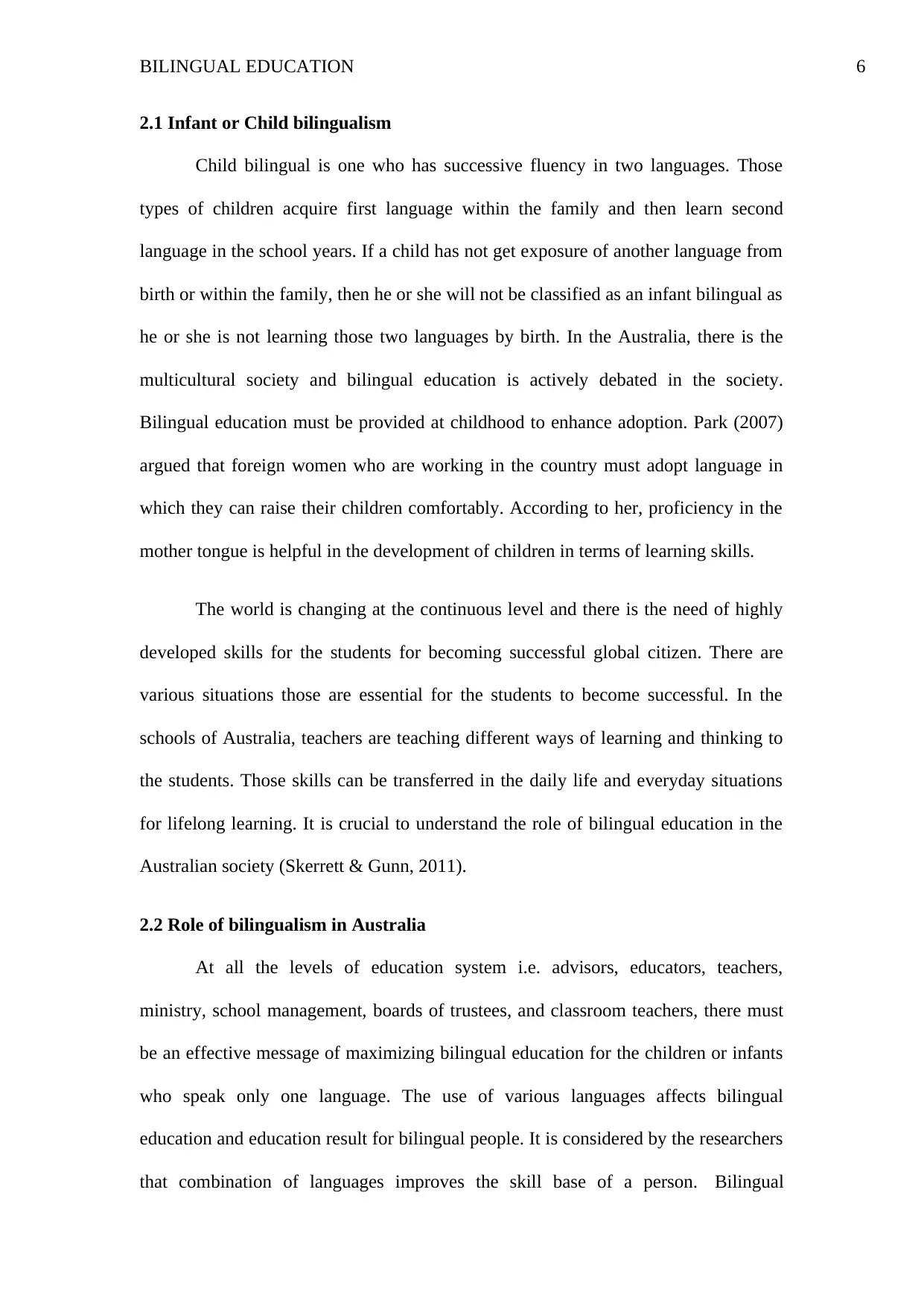
BILINGUAL EDUCATION 6
2.1 Infant or Child bilingualism
Child bilingual is one who has successive fluency in two languages. Those
types of children acquire first language within the family and then learn second
language in the school years. If a child has not get exposure of another language from
birth or within the family, then he or she will not be classified as an infant bilingual as
he or she is not learning those two languages by birth. In the Australia, there is the
multicultural society and bilingual education is actively debated in the society.
Bilingual education must be provided at childhood to enhance adoption. Park (2007)
argued that foreign women who are working in the country must adopt language in
which they can raise their children comfortably. According to her, proficiency in the
mother tongue is helpful in the development of children in terms of learning skills.
The world is changing at the continuous level and there is the need of highly
developed skills for the students for becoming successful global citizen. There are
various situations those are essential for the students to become successful. In the
schools of Australia, teachers are teaching different ways of learning and thinking to
the students. Those skills can be transferred in the daily life and everyday situations
for lifelong learning. It is crucial to understand the role of bilingual education in the
Australian society (Skerrett & Gunn, 2011).
2.2 Role of bilingualism in Australia
At all the levels of education system i.e. advisors, educators, teachers,
ministry, school management, boards of trustees, and classroom teachers, there must
be an effective message of maximizing bilingual education for the children or infants
who speak only one language. The use of various languages affects bilingual
education and education result for bilingual people. It is considered by the researchers
that combination of languages improves the skill base of a person. Bilingual
2.1 Infant or Child bilingualism
Child bilingual is one who has successive fluency in two languages. Those
types of children acquire first language within the family and then learn second
language in the school years. If a child has not get exposure of another language from
birth or within the family, then he or she will not be classified as an infant bilingual as
he or she is not learning those two languages by birth. In the Australia, there is the
multicultural society and bilingual education is actively debated in the society.
Bilingual education must be provided at childhood to enhance adoption. Park (2007)
argued that foreign women who are working in the country must adopt language in
which they can raise their children comfortably. According to her, proficiency in the
mother tongue is helpful in the development of children in terms of learning skills.
The world is changing at the continuous level and there is the need of highly
developed skills for the students for becoming successful global citizen. There are
various situations those are essential for the students to become successful. In the
schools of Australia, teachers are teaching different ways of learning and thinking to
the students. Those skills can be transferred in the daily life and everyday situations
for lifelong learning. It is crucial to understand the role of bilingual education in the
Australian society (Skerrett & Gunn, 2011).
2.2 Role of bilingualism in Australia
At all the levels of education system i.e. advisors, educators, teachers,
ministry, school management, boards of trustees, and classroom teachers, there must
be an effective message of maximizing bilingual education for the children or infants
who speak only one language. The use of various languages affects bilingual
education and education result for bilingual people. It is considered by the researchers
that combination of languages improves the skill base of a person. Bilingual
⊘ This is a preview!⊘
Do you want full access?
Subscribe today to unlock all pages.

Trusted by 1+ million students worldwide
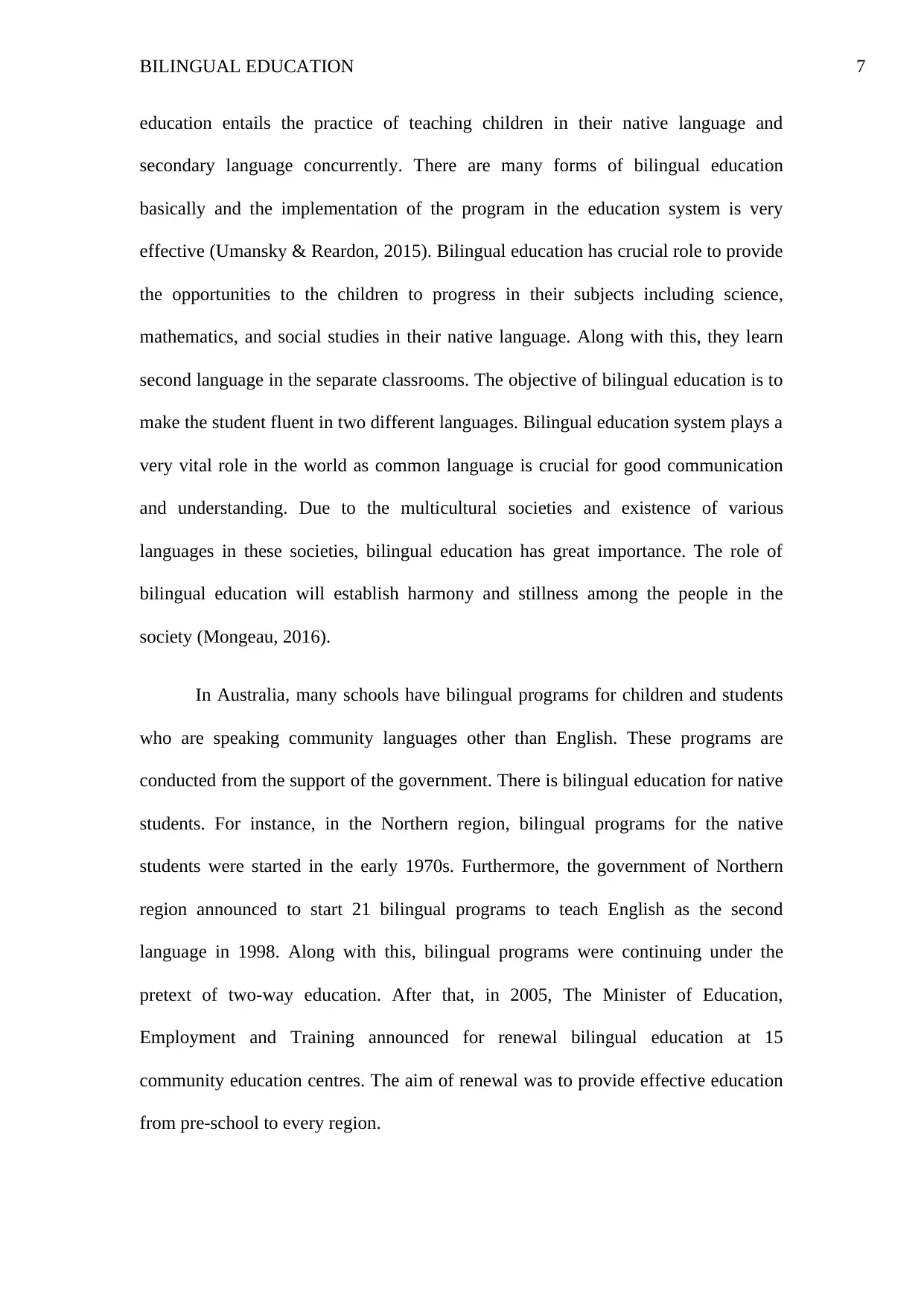
BILINGUAL EDUCATION 7
education entails the practice of teaching children in their native language and
secondary language concurrently. There are many forms of bilingual education
basically and the implementation of the program in the education system is very
effective (Umansky & Reardon, 2015). Bilingual education has crucial role to provide
the opportunities to the children to progress in their subjects including science,
mathematics, and social studies in their native language. Along with this, they learn
second language in the separate classrooms. The objective of bilingual education is to
make the student fluent in two different languages. Bilingual education system plays a
very vital role in the world as common language is crucial for good communication
and understanding. Due to the multicultural societies and existence of various
languages in these societies, bilingual education has great importance. The role of
bilingual education will establish harmony and stillness among the people in the
society (Mongeau, 2016).
In Australia, many schools have bilingual programs for children and students
who are speaking community languages other than English. These programs are
conducted from the support of the government. There is bilingual education for native
students. For instance, in the Northern region, bilingual programs for the native
students were started in the early 1970s. Furthermore, the government of Northern
region announced to start 21 bilingual programs to teach English as the second
language in 1998. Along with this, bilingual programs were continuing under the
pretext of two-way education. After that, in 2005, The Minister of Education,
Employment and Training announced for renewal bilingual education at 15
community education centres. The aim of renewal was to provide effective education
from pre-school to every region.
education entails the practice of teaching children in their native language and
secondary language concurrently. There are many forms of bilingual education
basically and the implementation of the program in the education system is very
effective (Umansky & Reardon, 2015). Bilingual education has crucial role to provide
the opportunities to the children to progress in their subjects including science,
mathematics, and social studies in their native language. Along with this, they learn
second language in the separate classrooms. The objective of bilingual education is to
make the student fluent in two different languages. Bilingual education system plays a
very vital role in the world as common language is crucial for good communication
and understanding. Due to the multicultural societies and existence of various
languages in these societies, bilingual education has great importance. The role of
bilingual education will establish harmony and stillness among the people in the
society (Mongeau, 2016).
In Australia, many schools have bilingual programs for children and students
who are speaking community languages other than English. These programs are
conducted from the support of the government. There is bilingual education for native
students. For instance, in the Northern region, bilingual programs for the native
students were started in the early 1970s. Furthermore, the government of Northern
region announced to start 21 bilingual programs to teach English as the second
language in 1998. Along with this, bilingual programs were continuing under the
pretext of two-way education. After that, in 2005, The Minister of Education,
Employment and Training announced for renewal bilingual education at 15
community education centres. The aim of renewal was to provide effective education
from pre-school to every region.
Paraphrase This Document
Need a fresh take? Get an instant paraphrase of this document with our AI Paraphraser
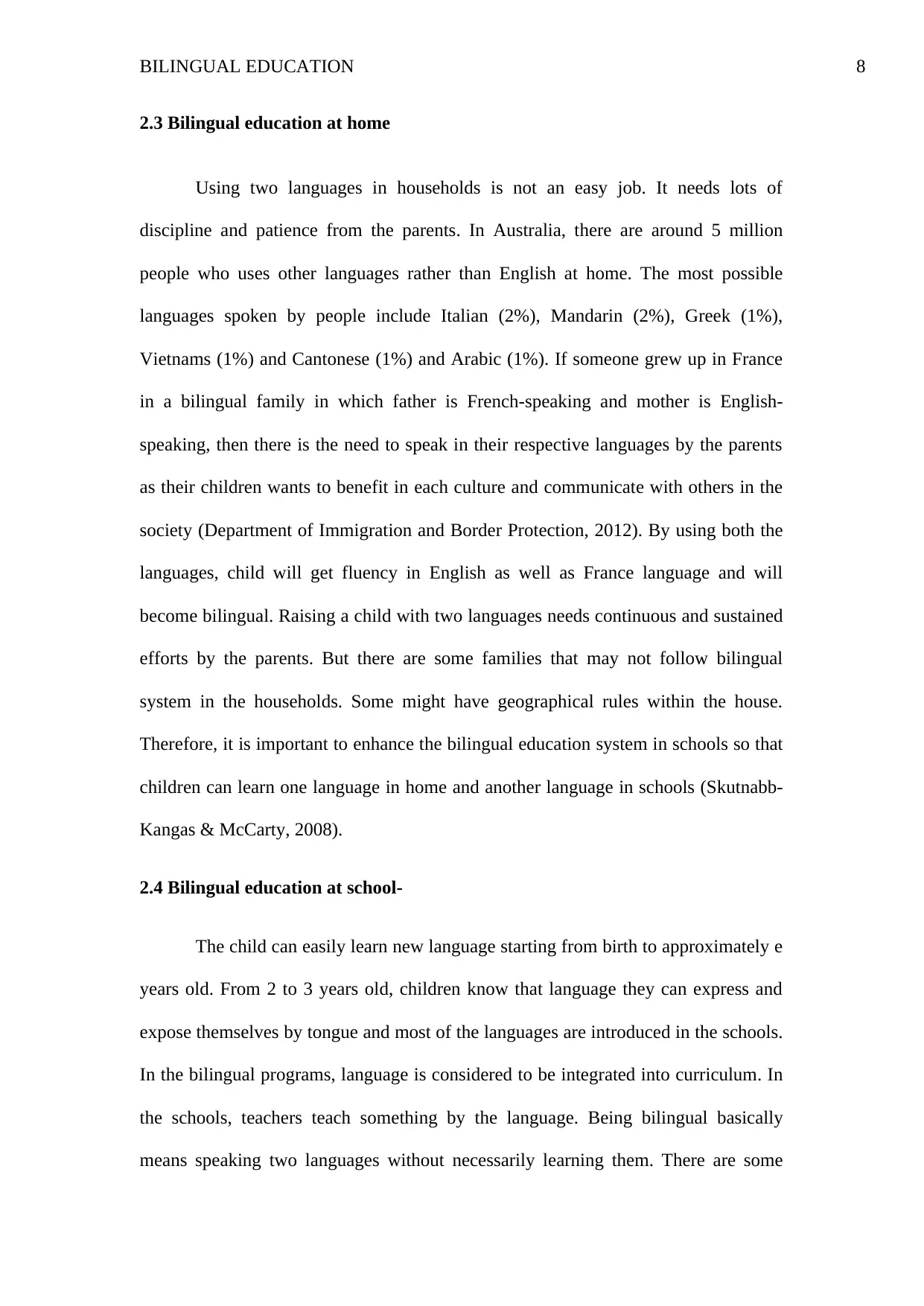
BILINGUAL EDUCATION 8
2.3 Bilingual education at home
Using two languages in households is not an easy job. It needs lots of
discipline and patience from the parents. In Australia, there are around 5 million
people who uses other languages rather than English at home. The most possible
languages spoken by people include Italian (2%), Mandarin (2%), Greek (1%),
Vietnams (1%) and Cantonese (1%) and Arabic (1%). If someone grew up in France
in a bilingual family in which father is French-speaking and mother is English-
speaking, then there is the need to speak in their respective languages by the parents
as their children wants to benefit in each culture and communicate with others in the
society (Department of Immigration and Border Protection, 2012). By using both the
languages, child will get fluency in English as well as France language and will
become bilingual. Raising a child with two languages needs continuous and sustained
efforts by the parents. But there are some families that may not follow bilingual
system in the households. Some might have geographical rules within the house.
Therefore, it is important to enhance the bilingual education system in schools so that
children can learn one language in home and another language in schools (Skutnabb-
Kangas & McCarty, 2008).
2.4 Bilingual education at school-
The child can easily learn new language starting from birth to approximately e
years old. From 2 to 3 years old, children know that language they can express and
expose themselves by tongue and most of the languages are introduced in the schools.
In the bilingual programs, language is considered to be integrated into curriculum. In
the schools, teachers teach something by the language. Being bilingual basically
means speaking two languages without necessarily learning them. There are some
2.3 Bilingual education at home
Using two languages in households is not an easy job. It needs lots of
discipline and patience from the parents. In Australia, there are around 5 million
people who uses other languages rather than English at home. The most possible
languages spoken by people include Italian (2%), Mandarin (2%), Greek (1%),
Vietnams (1%) and Cantonese (1%) and Arabic (1%). If someone grew up in France
in a bilingual family in which father is French-speaking and mother is English-
speaking, then there is the need to speak in their respective languages by the parents
as their children wants to benefit in each culture and communicate with others in the
society (Department of Immigration and Border Protection, 2012). By using both the
languages, child will get fluency in English as well as France language and will
become bilingual. Raising a child with two languages needs continuous and sustained
efforts by the parents. But there are some families that may not follow bilingual
system in the households. Some might have geographical rules within the house.
Therefore, it is important to enhance the bilingual education system in schools so that
children can learn one language in home and another language in schools (Skutnabb-
Kangas & McCarty, 2008).
2.4 Bilingual education at school-
The child can easily learn new language starting from birth to approximately e
years old. From 2 to 3 years old, children know that language they can express and
expose themselves by tongue and most of the languages are introduced in the schools.
In the bilingual programs, language is considered to be integrated into curriculum. In
the schools, teachers teach something by the language. Being bilingual basically
means speaking two languages without necessarily learning them. There are some
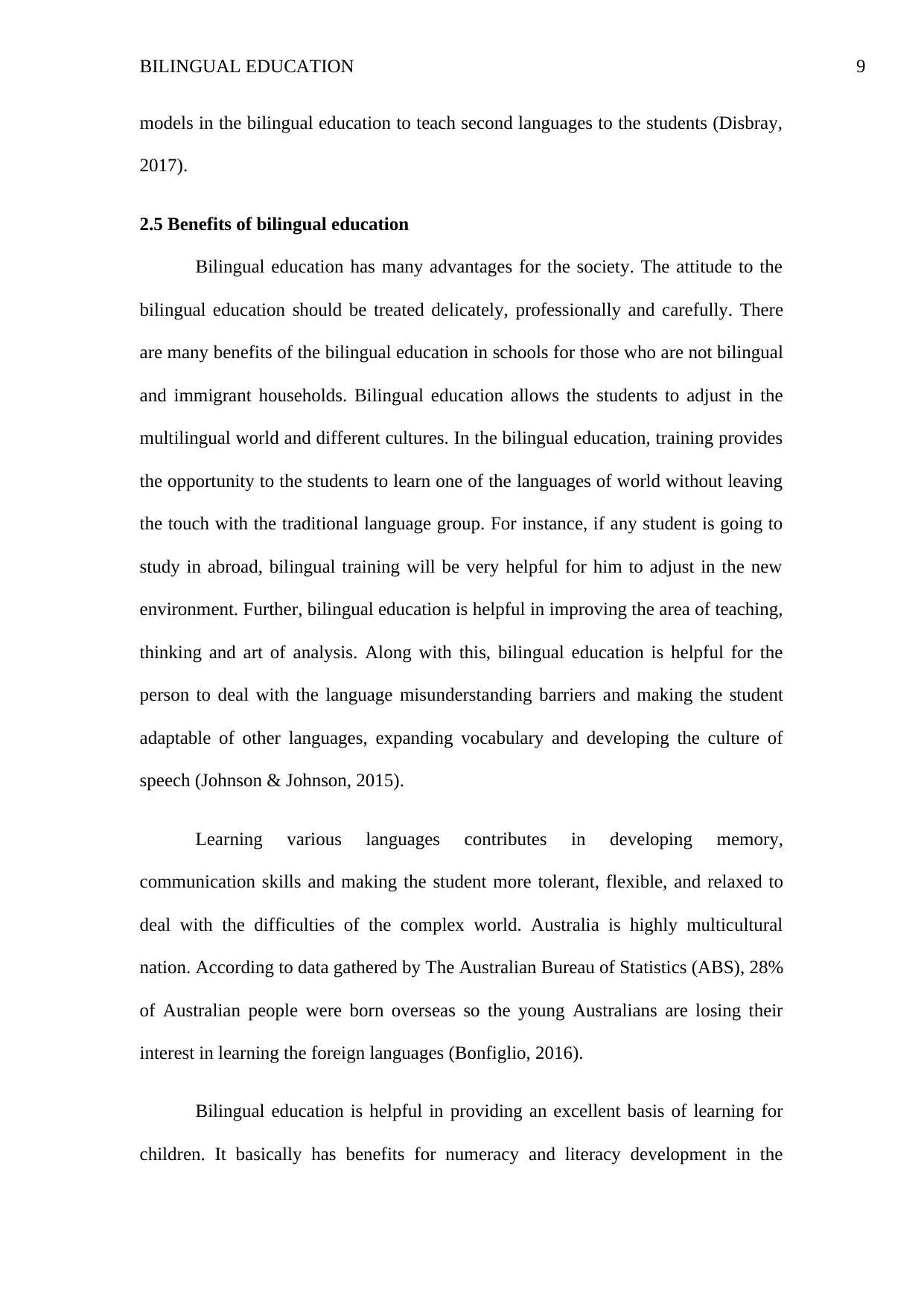
BILINGUAL EDUCATION 9
models in the bilingual education to teach second languages to the students (Disbray,
2017).
2.5 Benefits of bilingual education
Bilingual education has many advantages for the society. The attitude to the
bilingual education should be treated delicately, professionally and carefully. There
are many benefits of the bilingual education in schools for those who are not bilingual
and immigrant households. Bilingual education allows the students to adjust in the
multilingual world and different cultures. In the bilingual education, training provides
the opportunity to the students to learn one of the languages of world without leaving
the touch with the traditional language group. For instance, if any student is going to
study in abroad, bilingual training will be very helpful for him to adjust in the new
environment. Further, bilingual education is helpful in improving the area of teaching,
thinking and art of analysis. Along with this, bilingual education is helpful for the
person to deal with the language misunderstanding barriers and making the student
adaptable of other languages, expanding vocabulary and developing the culture of
speech (Johnson & Johnson, 2015).
Learning various languages contributes in developing memory,
communication skills and making the student more tolerant, flexible, and relaxed to
deal with the difficulties of the complex world. Australia is highly multicultural
nation. According to data gathered by The Australian Bureau of Statistics (ABS), 28%
of Australian people were born overseas so the young Australians are losing their
interest in learning the foreign languages (Bonfiglio, 2016).
Bilingual education is helpful in providing an excellent basis of learning for
children. It basically has benefits for numeracy and literacy development in the
models in the bilingual education to teach second languages to the students (Disbray,
2017).
2.5 Benefits of bilingual education
Bilingual education has many advantages for the society. The attitude to the
bilingual education should be treated delicately, professionally and carefully. There
are many benefits of the bilingual education in schools for those who are not bilingual
and immigrant households. Bilingual education allows the students to adjust in the
multilingual world and different cultures. In the bilingual education, training provides
the opportunity to the students to learn one of the languages of world without leaving
the touch with the traditional language group. For instance, if any student is going to
study in abroad, bilingual training will be very helpful for him to adjust in the new
environment. Further, bilingual education is helpful in improving the area of teaching,
thinking and art of analysis. Along with this, bilingual education is helpful for the
person to deal with the language misunderstanding barriers and making the student
adaptable of other languages, expanding vocabulary and developing the culture of
speech (Johnson & Johnson, 2015).
Learning various languages contributes in developing memory,
communication skills and making the student more tolerant, flexible, and relaxed to
deal with the difficulties of the complex world. Australia is highly multicultural
nation. According to data gathered by The Australian Bureau of Statistics (ABS), 28%
of Australian people were born overseas so the young Australians are losing their
interest in learning the foreign languages (Bonfiglio, 2016).
Bilingual education is helpful in providing an excellent basis of learning for
children. It basically has benefits for numeracy and literacy development in the
⊘ This is a preview!⊘
Do you want full access?
Subscribe today to unlock all pages.

Trusted by 1+ million students worldwide
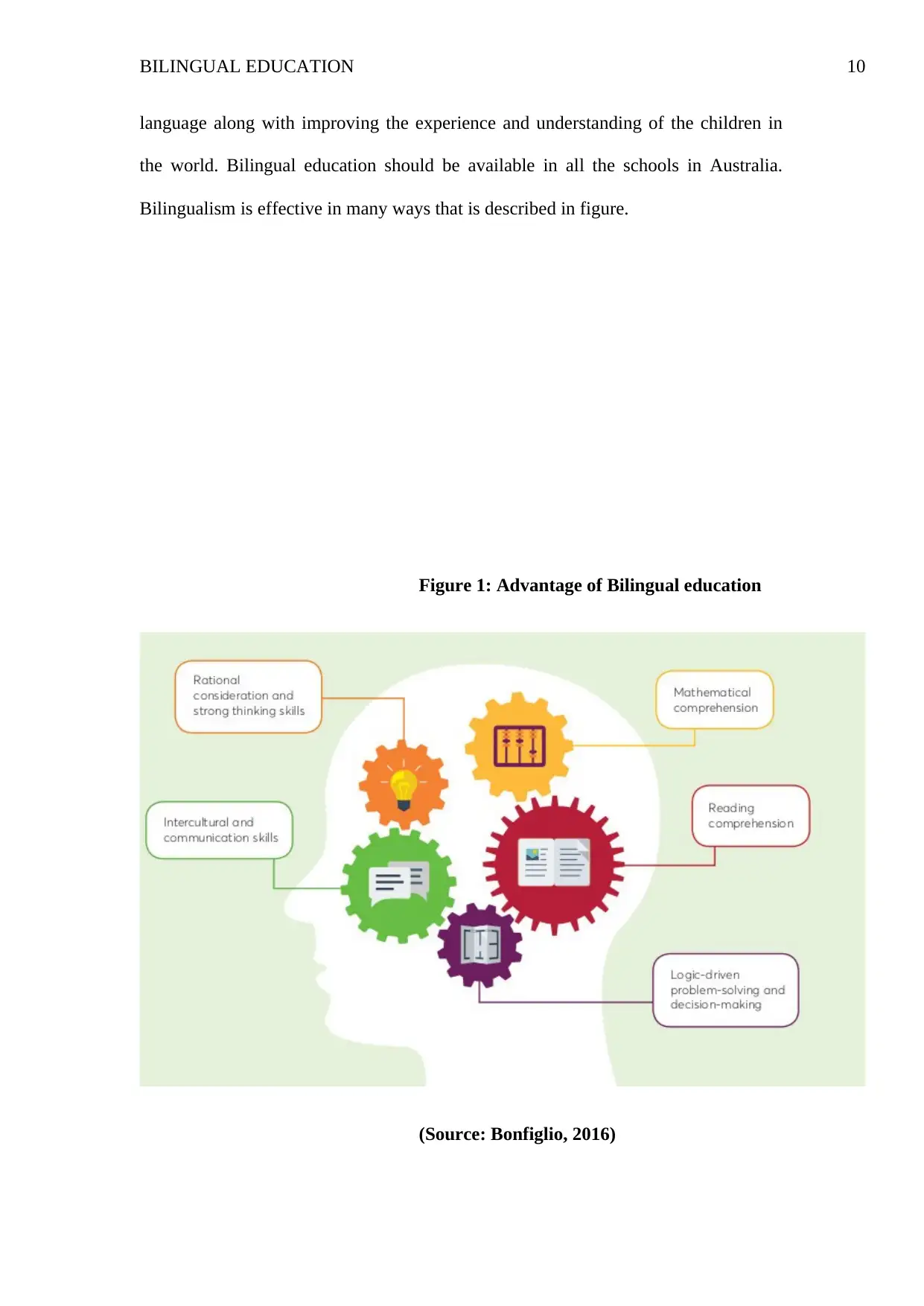
BILINGUAL EDUCATION 10
language along with improving the experience and understanding of the children in
the world. Bilingual education should be available in all the schools in Australia.
Bilingualism is effective in many ways that is described in figure.
Figure 1: Advantage of Bilingual education
(Source: Bonfiglio, 2016)
language along with improving the experience and understanding of the children in
the world. Bilingual education should be available in all the schools in Australia.
Bilingualism is effective in many ways that is described in figure.
Figure 1: Advantage of Bilingual education
(Source: Bonfiglio, 2016)
Paraphrase This Document
Need a fresh take? Get an instant paraphrase of this document with our AI Paraphraser
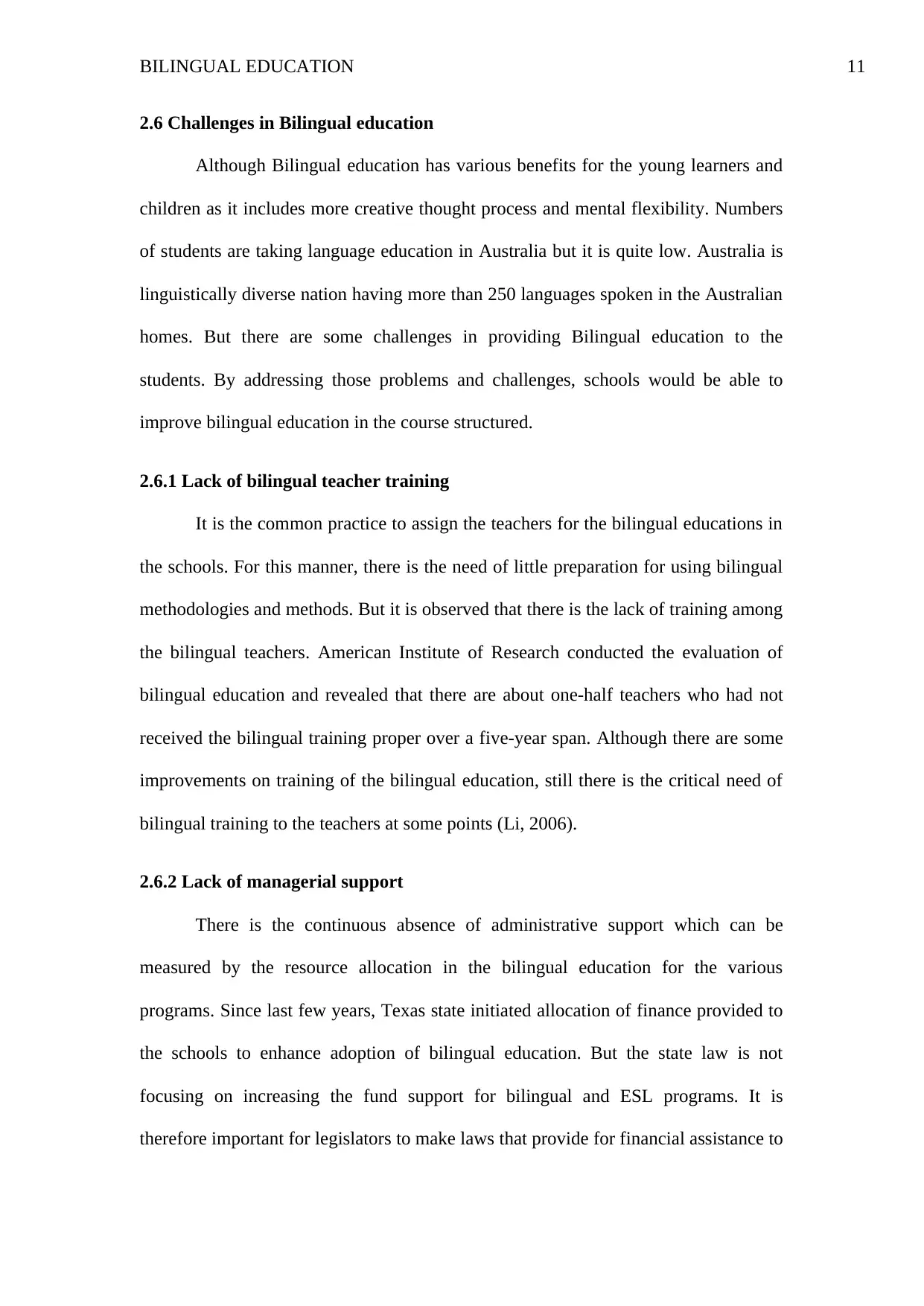
BILINGUAL EDUCATION 11
2.6 Challenges in Bilingual education
Although Bilingual education has various benefits for the young learners and
children as it includes more creative thought process and mental flexibility. Numbers
of students are taking language education in Australia but it is quite low. Australia is
linguistically diverse nation having more than 250 languages spoken in the Australian
homes. But there are some challenges in providing Bilingual education to the
students. By addressing those problems and challenges, schools would be able to
improve bilingual education in the course structured.
2.6.1 Lack of bilingual teacher training
It is the common practice to assign the teachers for the bilingual educations in
the schools. For this manner, there is the need of little preparation for using bilingual
methodologies and methods. But it is observed that there is the lack of training among
the bilingual teachers. American Institute of Research conducted the evaluation of
bilingual education and revealed that there are about one-half teachers who had not
received the bilingual training proper over a five-year span. Although there are some
improvements on training of the bilingual education, still there is the critical need of
bilingual training to the teachers at some points (Li, 2006).
2.6.2 Lack of managerial support
There is the continuous absence of administrative support which can be
measured by the resource allocation in the bilingual education for the various
programs. Since last few years, Texas state initiated allocation of finance provided to
the schools to enhance adoption of bilingual education. But the state law is not
focusing on increasing the fund support for bilingual and ESL programs. It is
therefore important for legislators to make laws that provide for financial assistance to
2.6 Challenges in Bilingual education
Although Bilingual education has various benefits for the young learners and
children as it includes more creative thought process and mental flexibility. Numbers
of students are taking language education in Australia but it is quite low. Australia is
linguistically diverse nation having more than 250 languages spoken in the Australian
homes. But there are some challenges in providing Bilingual education to the
students. By addressing those problems and challenges, schools would be able to
improve bilingual education in the course structured.
2.6.1 Lack of bilingual teacher training
It is the common practice to assign the teachers for the bilingual educations in
the schools. For this manner, there is the need of little preparation for using bilingual
methodologies and methods. But it is observed that there is the lack of training among
the bilingual teachers. American Institute of Research conducted the evaluation of
bilingual education and revealed that there are about one-half teachers who had not
received the bilingual training proper over a five-year span. Although there are some
improvements on training of the bilingual education, still there is the critical need of
bilingual training to the teachers at some points (Li, 2006).
2.6.2 Lack of managerial support
There is the continuous absence of administrative support which can be
measured by the resource allocation in the bilingual education for the various
programs. Since last few years, Texas state initiated allocation of finance provided to
the schools to enhance adoption of bilingual education. But the state law is not
focusing on increasing the fund support for bilingual and ESL programs. It is
therefore important for legislators to make laws that provide for financial assistance to
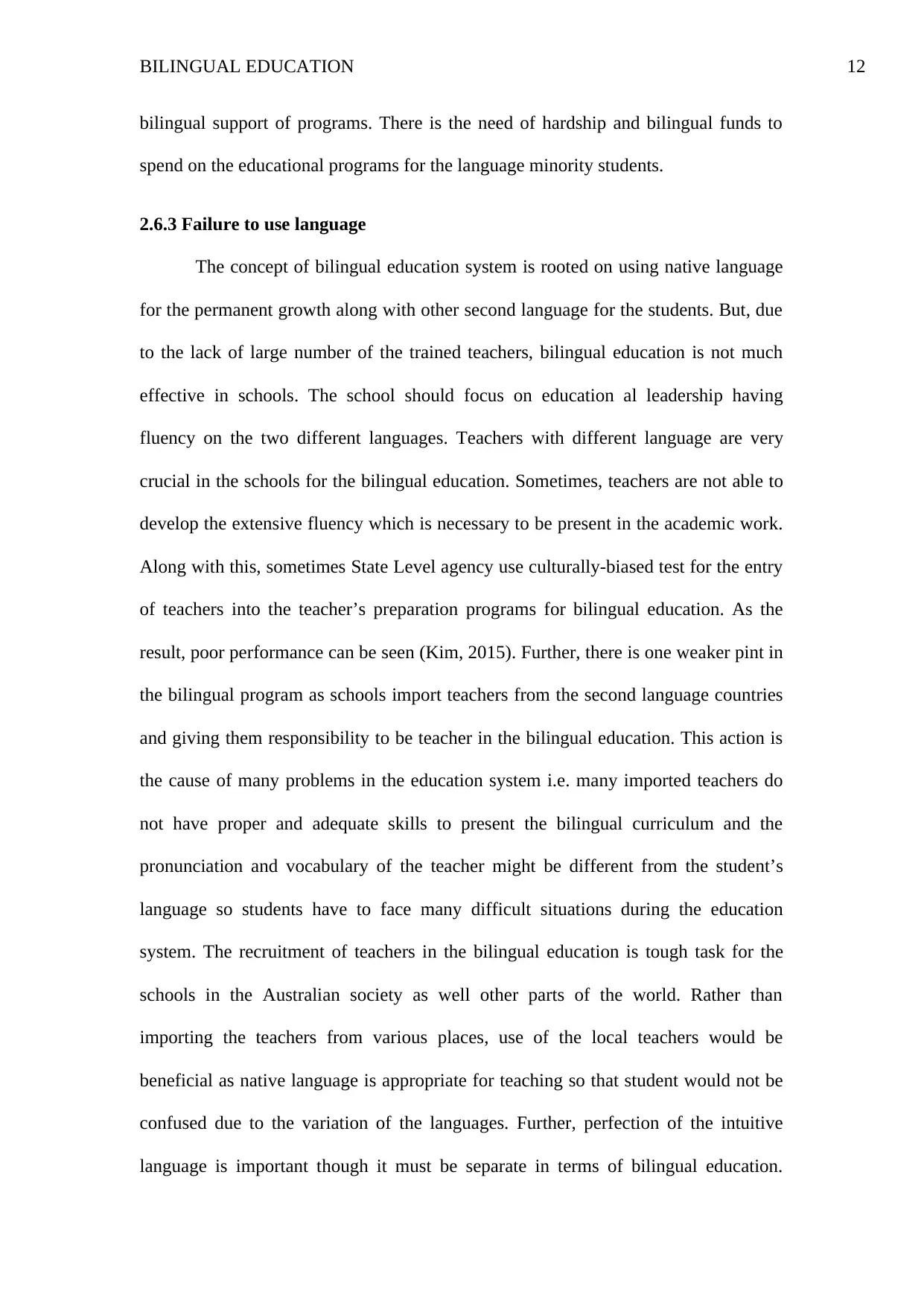
BILINGUAL EDUCATION 12
bilingual support of programs. There is the need of hardship and bilingual funds to
spend on the educational programs for the language minority students.
2.6.3 Failure to use language
The concept of bilingual education system is rooted on using native language
for the permanent growth along with other second language for the students. But, due
to the lack of large number of the trained teachers, bilingual education is not much
effective in schools. The school should focus on education al leadership having
fluency on the two different languages. Teachers with different language are very
crucial in the schools for the bilingual education. Sometimes, teachers are not able to
develop the extensive fluency which is necessary to be present in the academic work.
Along with this, sometimes State Level agency use culturally-biased test for the entry
of teachers into the teacher’s preparation programs for bilingual education. As the
result, poor performance can be seen (Kim, 2015). Further, there is one weaker pint in
the bilingual program as schools import teachers from the second language countries
and giving them responsibility to be teacher in the bilingual education. This action is
the cause of many problems in the education system i.e. many imported teachers do
not have proper and adequate skills to present the bilingual curriculum and the
pronunciation and vocabulary of the teacher might be different from the student’s
language so students have to face many difficult situations during the education
system. The recruitment of teachers in the bilingual education is tough task for the
schools in the Australian society as well other parts of the world. Rather than
importing the teachers from various places, use of the local teachers would be
beneficial as native language is appropriate for teaching so that student would not be
confused due to the variation of the languages. Further, perfection of the intuitive
language is important though it must be separate in terms of bilingual education.
bilingual support of programs. There is the need of hardship and bilingual funds to
spend on the educational programs for the language minority students.
2.6.3 Failure to use language
The concept of bilingual education system is rooted on using native language
for the permanent growth along with other second language for the students. But, due
to the lack of large number of the trained teachers, bilingual education is not much
effective in schools. The school should focus on education al leadership having
fluency on the two different languages. Teachers with different language are very
crucial in the schools for the bilingual education. Sometimes, teachers are not able to
develop the extensive fluency which is necessary to be present in the academic work.
Along with this, sometimes State Level agency use culturally-biased test for the entry
of teachers into the teacher’s preparation programs for bilingual education. As the
result, poor performance can be seen (Kim, 2015). Further, there is one weaker pint in
the bilingual program as schools import teachers from the second language countries
and giving them responsibility to be teacher in the bilingual education. This action is
the cause of many problems in the education system i.e. many imported teachers do
not have proper and adequate skills to present the bilingual curriculum and the
pronunciation and vocabulary of the teacher might be different from the student’s
language so students have to face many difficult situations during the education
system. The recruitment of teachers in the bilingual education is tough task for the
schools in the Australian society as well other parts of the world. Rather than
importing the teachers from various places, use of the local teachers would be
beneficial as native language is appropriate for teaching so that student would not be
confused due to the variation of the languages. Further, perfection of the intuitive
language is important though it must be separate in terms of bilingual education.
⊘ This is a preview!⊘
Do you want full access?
Subscribe today to unlock all pages.

Trusted by 1+ million students worldwide
1 out of 31
Related Documents
Your All-in-One AI-Powered Toolkit for Academic Success.
+13062052269
info@desklib.com
Available 24*7 on WhatsApp / Email
![[object Object]](/_next/static/media/star-bottom.7253800d.svg)
Unlock your academic potential
Copyright © 2020–2025 A2Z Services. All Rights Reserved. Developed and managed by ZUCOL.





